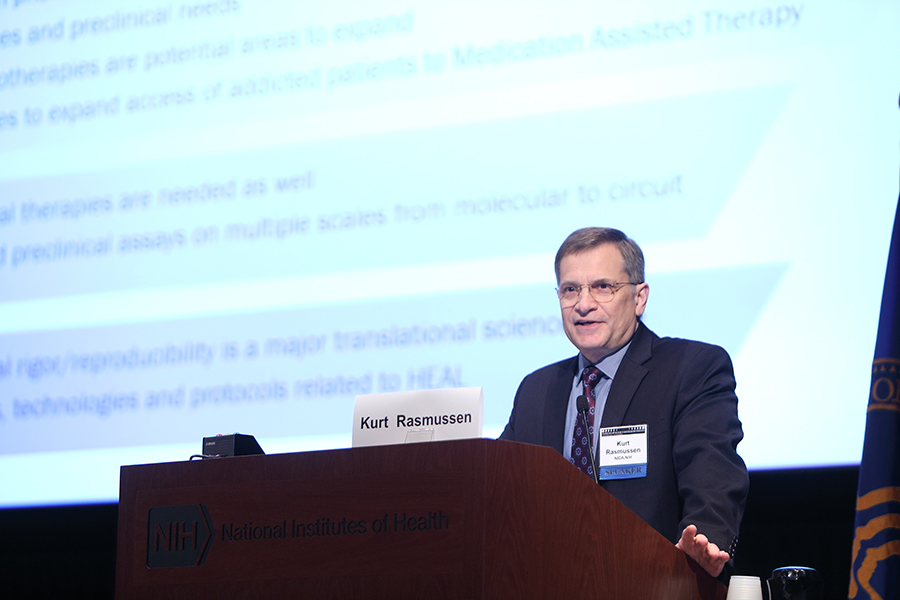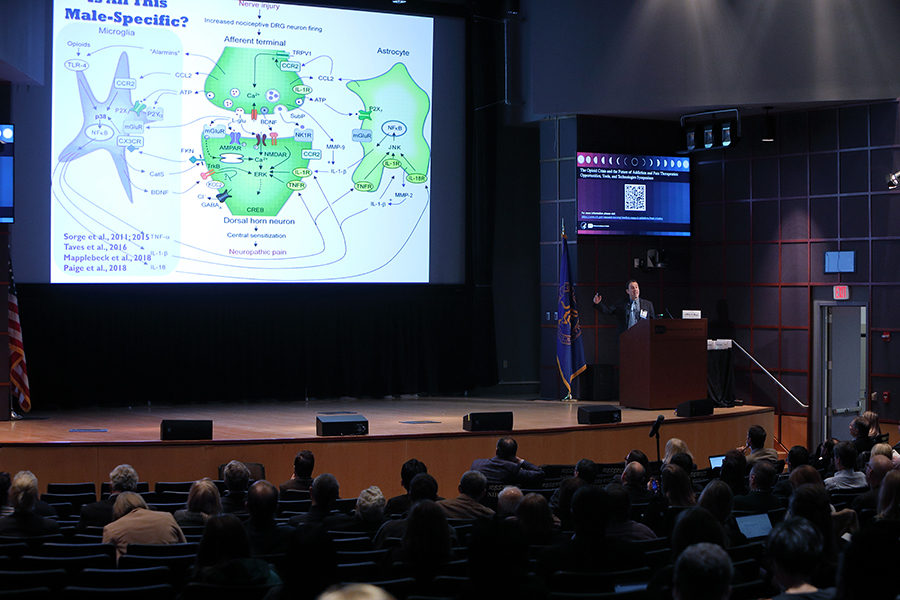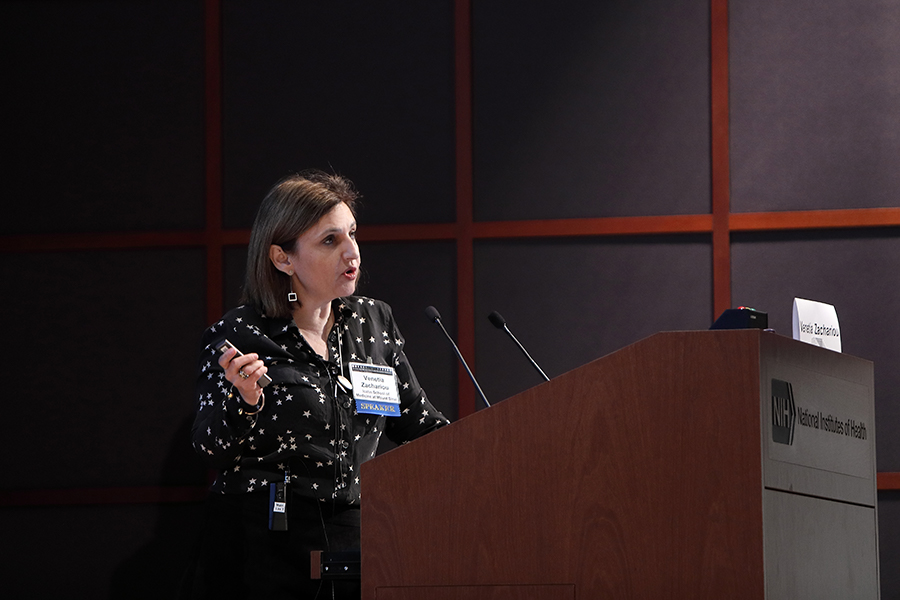Researchers Convene to Take Stock and Take Action in the Opioid Crisis
March 28, 2019
In a large lecture hall, leading pain and addiction researchers watched a video of zebrafish swimming in a tank. The fish swam back and forth over a small square, triggering the release of hydrocodone, an opioid prescribed for pain, into the tank. These zebrafish were showing some of the same signs of addiction that humans exhibit. These included taking more hydrocodone over time and engaging in risky behavior to get it, explained Randall Peterson, Ph.D., a chemical biologist at the University of Utah.
“What does risky behavior in a fish look like?” an audience member asked. Peterson clarified that fish usually avoid shallow areas of the tank where predators may lurk. However, zebrafish will venture into the shallow area if it is the only way to release more of the drug. Peterson will be able to use the shallow water test to look for new drugs that stop addictive behaviors in the fish — and, hopefully, to develop new therapies for addiction in humans.
This test was one of many innovative approaches to finding new treatments for addiction or pain highlighted by researchers at The Opioid Crisis and the Future of Addiction and Pain Therapeutics: Opportunities, Tools, and Technologies Symposium in February 2019. NCATS co-hosted the two-day symposium with the National Institute on Drug Abuse (NIDA) and the National Institute of Neurological Disorders and Stroke (NINDS) as part of the Helping to End Addiction Long-termSM Initiative, or NIH HEAL InitiativeSM, a trans-NIH effort to address the opioid crisis through science.
“This special meeting brought together the two sides of this scientific and medical and public health problem: the addiction and overdose side and the pain side,” said Christopher P. Austin, M.D., NCATS director, in his welcoming remarks. “We hope it will lead to new insights that otherwise wouldn’t happen.”
Symposium participants discussed why it has been so difficult to find effective treatments for pain or addiction and highlighted innovative approaches to make inroads into the opioid crisis. But the urgency of the crisis, with more than 70,000 deaths in the United States last year, remained front and center in participants’ minds.

Kurt Rasmussen, Ph.D., Director of the Division of Therapeutics and Medical Consequences at NIDA, gives a summary of the first day of the symposium. (Image Caffeine Photography, LLC Photo/Chia Chi Charlie Chang)
“I can say without hyperbole that people are dying and families are torn apart because of addiction, and the people in this room have the ability to help,” said Kurt Rasmussen, Ph.D., Director of the Division of Therapeutics and Medical Consequences at NIDA and co-organizer of the symposium. “As a result of this symposium, think, ‘What will I do differently to help in this crisis?’ What new experiment will you do? What new collaboration or grant or technique will you pursue?”
Think Differently: New Assays and Approaches
Most people first encounter an opioid when their doctor prescribes a painkiller. Prescription opioids attach to opioid receptors in the brain, similar to a key inside a lock. This turns the receptors on, which tells the brain to block the sensation and awareness of pain. The problem is that the receptors are located in the areas of the brain that inhibit breathing — which can lead to death from an overdose — and in the main reward center of the brain, making opioids highly addictive. In addition, individuals who use opioids long-term will eventually develop a tolerance to the effects of the drug.
Researchers are working to develop new treatments for chronic pain that are not addictive. Some are looking at ways to turn on the opioid receptors in a way that blocks pain but doesn’t affect breathing or reward signaling. Others are targeting alternative opioid receptors that are not located in the reward center of the brain.
Many researchers called for consideration of radically different approaches to therapy development. In his keynote talk at the symposium, Clifford Woolf, Ph.D., a neurobiologist at Boston Children’s Hospital, discussed why the target-based approach has not worked well. Woolf believes that many genes contribute to pain. A drug that blocks multiple proteins, which these genes code for, may be more effective than a drug targeting a single protein. To find the genes involved in pain, he and others called for large genetic studies on people who have chronic pain. Such studies, which have been done for diseases like asthma and depression, would help identify new drug targets for pain.
Woolf and others at the symposium want better assays (tests) using human cells to mimic pain. For example, researchers can take skin or blood cells from a patient and reprogram them to become induced pluripotent stem cells (iPSCs) that can become other kinds of cells, including pain-sensing nerve cells. When these nerve cells are activated, they send electric signals to the brain that translate to pain. Woolf can measure this activity and test for molecules that reduce it. He highlighted how researchers used this approach to correctly predict whether a patient would respond to a pain treatment.
“This is what precision medicine can be about,” Woolf said. “I know NCATS is devoting efforts to utilize this, and I think it’s going to be transformative.”
Better Animal Models
Problems with current animal models of pain are another reason that promising pain treatments fail during clinical trials, said Jeffrey Mogil, Ph.D., a pain researcher at McGill University.
Mogil highlighted a significant issue in preclinical research: Around 70 percent of pain patients are women, yet just a couple of years ago, Mogil found that 79 percent of animal studies published in Pain looked only at males. That changed when NIH established a policy requiring NIH-funded researchers to include both sexes in animal studies.

Jeffrey Mogil, Ph.D., discusses differences in pain signaling between men and women. (Image Caffeine Photography, LLC Photo/Chia Chi Charlie Chang)
Now researchers are beginning to see what Mogil saw: The biology of pain is different in men and women. For example, Mogil said, about 10 years ago, scientists discovered that immune cells in the brain and spinal cord called microglia are important for pain signaling — but it turns out this is true only in male rats. Differences like this, which investigators are only beginning to understand, may explain why some pain treatments work better for men or women.
Next Steps and Taking Action
During the last session of the symposium, NCATS, NIDA and NINDS staff highlighted opportunities for funding and research collaboration, as well as resources to help researchers take those next steps. One such resource is NCATS’ Assay Guidance Manual, which inspired the symposium. The manual is a free online guide for developing rigorous assays for drug discovery. NCATS is currently compiling new tools, methodologies and technologies for pain and addiction research for the next update of the manual.
“There is tremendous urgency to help the many people dying of overdose and suffering from pain as we speak,” Austin said in his closing remarks. “I truly believe we can tackle this crisis, but we have to think about and do our science differently.”




